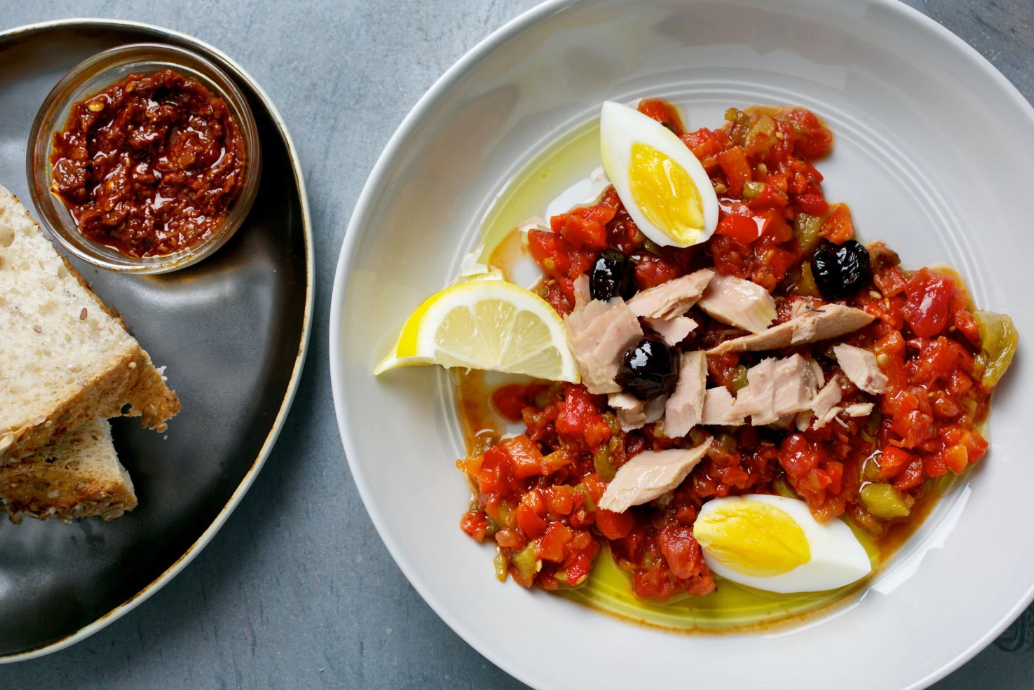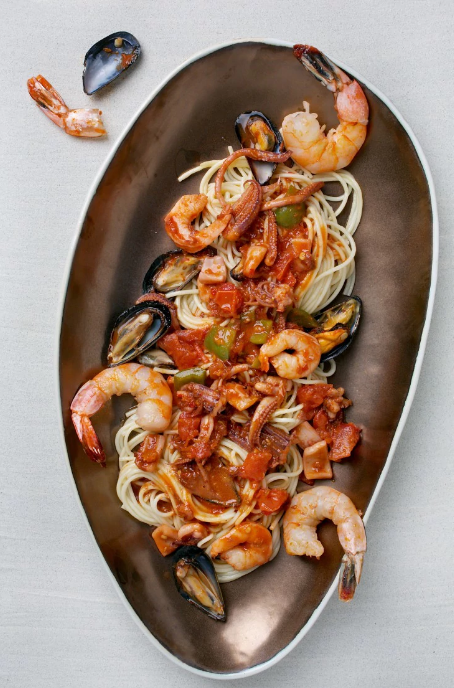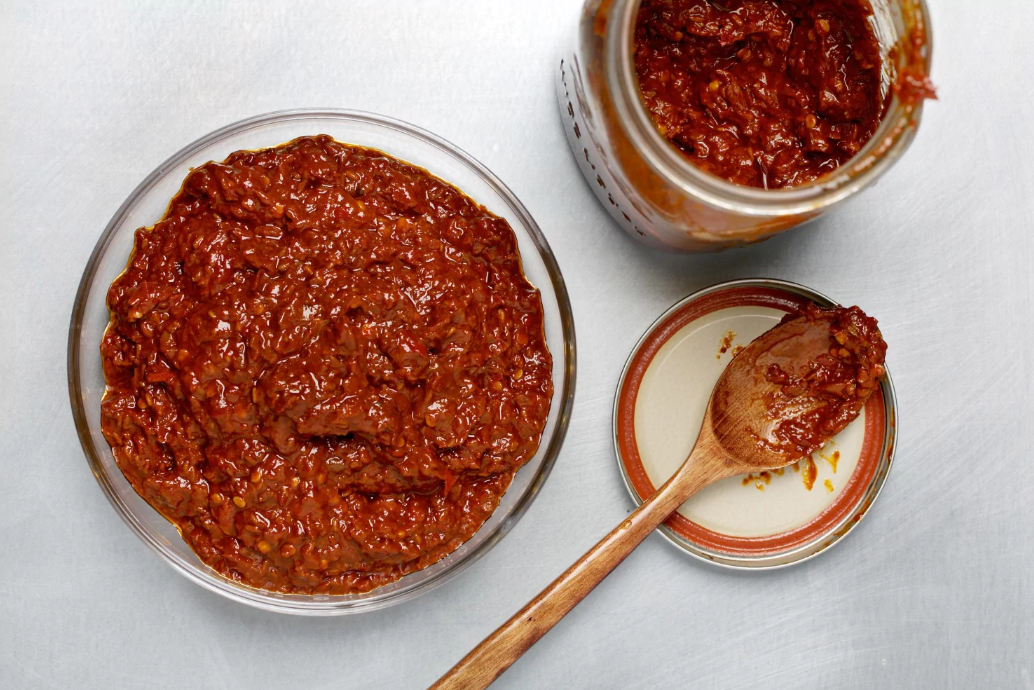Why this Tunisian chile paste is the new sriracha
Harissa is ubiquitous in its home country. It’s worth embracing here, too

Your support helps us to tell the story
From reproductive rights to climate change to Big Tech, The Independent is on the ground when the story is developing. Whether it's investigating the financials of Elon Musk's pro-Trump PAC or producing our latest documentary, 'The A Word', which shines a light on the American women fighting for reproductive rights, we know how important it is to parse out the facts from the messaging.
At such a critical moment in US history, we need reporters on the ground. Your donation allows us to keep sending journalists to speak to both sides of the story.
The Independent is trusted by Americans across the entire political spectrum. And unlike many other quality news outlets, we choose not to lock Americans out of our reporting and analysis with paywalls. We believe quality journalism should be available to everyone, paid for by those who can afford it.
Your support makes all the difference.In 2014, Food & Wine called it the “new sriracha” sauce. Time named it one of 2015’s food trends. Jamie Oliver has been using it in recipes for years. London’s Yotam Ottolenghi learned to make it for a 2013 episode of his BBC TV show Mediterranean Feast. US chefs have been playing with it, too; Seattle’s Renee Erickson features it in a delightfully fiery dish of roasted carrots and fennel.
While it hasn’t yet become the next sriracha, harissa – Tunisia’s delicious chilli paste and one of the world’s great condiments – deserves to be in every pantry. Robust and with a nutty, pungent earthiness behind the heat, it gives a range of dishes a vivacious and dynamic backbone with more complexity than most other hot sauces offer.

Since I fell for harissa on my first trip to Tunisia 12 years ago, it has become one of my kitchen staples. It goes into not only such Tunisian favourites as couscous and spicy seafood pasta, but a multitude of global dishes.
A spoonful whisked into mayonnaise makes a speedy and rich sauce that adds the depth of garlic, caraway and coriander to the classic Spanish dish of patatas bravas. It’s great for marinating skewers of chicken, delicious stirred into a pot of stewed lentils, and a spoonful adds a jaunty punch to scrambled eggs (particularly delicious when eaten as a vegetarian taco).
But if I have some homemade harissa on hand, or an artisanal jar from Tunisia, then I simply spoon some on a dish or give it a lacing of bold olive oil and use it as a dip for bread.

The heartland of harissa is Tunisia’s Cap Bon peninsula, which locals call terre rouge, or “red land”, not only for soil that deepens in hue in the late-afternoon light, but also for the different types of peppers that ripen and turn bright red in autumn. The capsicum peppers that reached Tunisia in the 16th century after being brought back to Spain from the New World took particularly well to the peninsula’s climate and soil. Fittingly, the country’s most famous harissa brand (and best-known export) is named for the lighthouse at its tip, Le Phare du Cap Bon.
The one thing you can’t ignore
Cap Bon juts off northeast Tunisia like a thumb pointing toward Sicily. From nearby Tunis, it takes four or five hours to circumnavigate. The road around the peninsula passes through commercial towns with busy weekly souks, ruins, old Roman villas, the fishing port of Kebilia – with an ancient fortress towering above it – and salt flats before ending in Nabeul on the southeast shore. Along the way, glimpses of the brilliant Mediterranean flash behind orderly rows of gnarled olive trees, vineyards and fields of melons, tomatoes and – most famous of all – peppers.
After being harvested, chilli peppers are sun-dried until the long, tapering pods, some five or six inches in length, turn a rich, ruddy crimson colour and take on a smooth, leathery sheen. It is a common sight to see a wire running over the patio of a home, with drying chillies and long ristras of dried ones hanging from hooks. The chillies are similar in shape and colour to larger New Mexico varieties.
While harissa is widely available in cans and tubes in stores, and by weight in market stalls that sell olives, preserved lemons and capers, many Tunisians prepare their own.
It’s simple, I was told repeatedly on a visit this summer by people in markets, spice shops and around Nabeul, the peninsula’s spice (and pottery) capital.

For harissa, the dried chillies are seeded and de-ribbed – this tones down some of the heat – and then soaked in water to soften. Tunisians used to laboriously pound them in a mortar, but today they generally use a hand-crank meat grinder (a food processor works fine, too). Garlic and salt are added to the paste as it gets passed a second time through the grinder. Those are the minimum additions. Classic harissa has caraway and coriander seeds stirred into it, and sometimes cumin. After being spooned into glass jars, it gets a generous covering of olive oil.
Few savoury dishes in Tunisia seem complete without a spoonful or two (or more) of the spicy paste. Cooks stir it into couscous broth, fish soups and tomato sauce for pasta, add it to salads of roasted red peppers or aubergine and spoon it onto grilled sardines with red mullet. Fricassee sandwiches sold on the street get a generous dollop, as do bowls of lablabi, the widely popular chickpea stew served over pieces of day-old bread.
And if it isn’t an ingredient, it can always be added. Rather than salt and pepper, Tunisians place a dish of harissa on the table.
Restaurants generally offer a slightly elaborated dish of it along with a basket of bread. The harissa is encircled by a moat of olive oil and topped with a few black olives and wild capers, a tongue-withering fresh chilli and lovely hunk of tuna to nibble on until the meal arrives.
In Tunisia, harissa is, as Ottolenghi noted, “the one thing you can’t ignore”. It is not only iconic but also ubiquitous.
While Tunisia is the largest producer and consumer of harissa in North Africa, it is also popular in Algeria and Libya and less so in Morocco. Taking pride in their ample spice box and sophisticated blending of sweet and savoury ingredients, Moroccans can be dismissive of harissa as a substitute for taste, even skill. While showing me how to hand-roll couscous grains some years ago, one woman informed me that “Tunisians add harissa because of a lack of flavour and imagination”.
Sure, its boldness can dominate, even overwhelm when used in excess (especially for those unaccustomed). But harissa added with a prudent hand brings a different dimension of flavour to a dish, and it’s easy to see such comments as the rhetoric of a culinary rivalry.

‘It’s written into their genetic code’
At the tip of Cap Bon, a few miles outside the quiet, isolated town of al Haouaria and reachable only on foot, is the lighthouse that lends the Le Phare du Cap Bon brand its name. From there, Italy is not far off; Sicily is only some 85 miles away, while the volcanic island of Pantelleria is just half that distance.
There are many similarities between the cuisine on that side of the Mediterranean and Tunisia: the abundance of tomatoes, olive oil and fish, of lovely capers and lemons.
But while dishes in Tunisia appear familiar, they have their own accent. There’s whole sea bream baked with tomatoes, but also black olives, wild capers and pungent preserved lemons; cuttlefish sauteed in olive oil and garlic, yet subtly seasoned with cumin; freshly squeezed lemonade pureed with fresh mint before being strained into glasses.
The strongest, most distinct accent, though, comes from the omnipresent condiment.
“All Tunisians use harissa,” said Hugues Blin, founder of A Table delicatessen, which sells Ksar artisanal harissa, one of my favorites. “It’s written into their genetic code.”
Harissa’s domination of the Tunisian palate remains unchallenged. It hasn’t conquered all Western tables just yet, but that might be only a matter of time.
Rose petal harissa

This is rich-tasting and mighty spicy, so use it sparingly.
Make ahead: the dried chillies for the harissa need to soak for at least 2 hours and up to 1 day. The harissa needs to cure in the refrigerator for 1 day before serving; it can be refrigerated in an airtight container for up to 2 months.
Dried rose petals and rose water are available at Mediterranean markets.
Adapted from A Boat, a Whale & a Walrus: Menus and Stories by Renee Erickson with Jess Thomson (Sasquatch Books, 2014).
Ingredients
85g dried guajillo chilli peppers, stemmed (not seeded)
45g dried aji amarillo chilli peppers (also sold as aji mirasol), stemmed (not seeded)
Boiling water
2½ tbsp caraway seeds
2 tbsp cumin seeds
1 tbsp coriander seeds
1½ tsp fennel seeds
3 large cloves garlic, coarsely chopped
1 tsp dried rose petals
10 to 12 tbsp lime juice (from 4 to 6 limes), or more as needed
¼ tsp rose water
60 ml extra virgin olive oil, plus more for storing
1 to 1½ tbsp kosher salt, or more as needed
Combine the chilli peppers in a medium pot, adding enough of the boiling water to cover them. Bring to a boil over high heat, then remove from the heat and weight the chillies with a smaller pan to ensure they’re all submerged. Allow them to sit, covered, for at least 2 hours or until they are soft (depending on the chillies, it might not take that long; just ensure the skins are soft). Drain and reserve the soaking water.
Combine the caraway, cumin, coriander and fennel seeds in a large saute pan over a medium heat. Cook for a few minutes, stirring frequently, until they are toasted and fragrant and some of them begin to pop. Transfer to a plate to cool.
Once the spices have cooled, transfer them to a food processor and pulse until the spices are ground almost to a powder. Add the garlic and rose petals, and pulse about 10 times to form a dry paste.
Working in two batches, and wearing gloves if you’re sensitive to spice, add half of the soaked chillies to the food processor, along with any water that comes along for the ride. Add half of the lime juice and half of the rose water; pulse until the chillies are finely chopped, stopping to scrape down the sides and top of the food processor bowl as needed. This might take 3 or 4 minutes total, so be patient. You’re looking for the texture of small-curd cottage cheese. If the mixture seems too thick, add some of the reserved cooking/soaking water, about 2 tablespoons at a time, until the mixture moves easily in the food processor.
Once the chillies are finely chopped, add half of the oil and half of the salt and pulse until well incorporated. Transfer to a container with a tight-fitting lid; add the remaining chillies, lime juice, rose water, oil and salt; add the processed mixture to the container.
Taste, adding some lime juice and/or salt, as needed. Cover and refrigerate for at least 1 day before using. To store long-term, scoop the harissa into pint-size jars, pour a thin layer of oil on top and refrigerate.
© Washington Post
Join our commenting forum
Join thought-provoking conversations, follow other Independent readers and see their replies
Comments